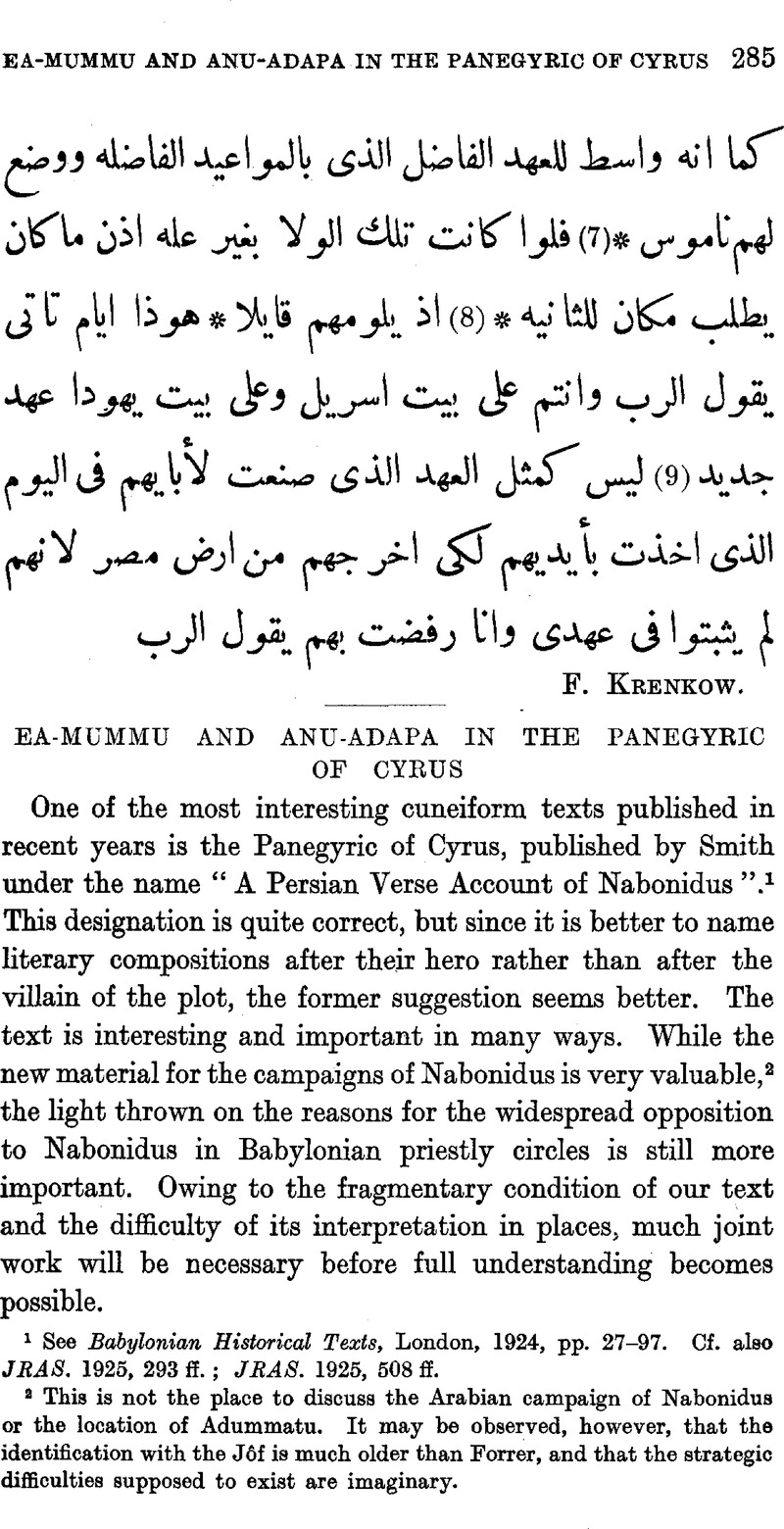No CrossRef data available.
Article contents
Ea-mummu and Anu-adapa in the Panegyric of Cyrus
Published online by Cambridge University Press: 15 March 2011
Abstract

- Type
- Miscellaneous Communications
- Information
- Copyright
- Copyright © The Royal Asiatic Society 1926
References
page 285 note 1 See Babylonian Historical Texts, London, 1924, pp. 27–97Google Scholar. Cf. also JRAS. 1925, 293 ff.; JRAS. 1925, 508 ff.
page 285 note 2 This is not the place to discuss the Arabian campaign of Nabonidus or the location of Adummatu. It may be observed, however, that the identification with the Jôf is much older than Forrer, and that the strategic difficulties supposed to exist are imaginary.
page 286 note 1 Instead of quoting at random, we may simply refer to Delitzsch, Assyrische Grammatik, p. 271 below. Instead of terming the verbal form ending in a an energic, we should call it paratactic, following Haupt.
page 287 note 1 Smith: “ He confounds the rites, he upsets the ordinances,” but bullulu and dulluḫu both mean “ to muddy, soil, defile ”. The semantic difference is, however, really very slight.
page 287 note 2 The word ṣîtu has two entirely distinct meanings, one derived from the stem wṣ’, the other from ṣy’ (HWB. 565b), which belongs here.
page 287 note 3 JRAS., 1925, 513, it is said to be certain that GIS.ḪAR, uṣurtu does not mean “ plan ”, but refers to some cult object—just what is not stated; Smith's own reference to a ritual published by him informs us that one enters an uṣurtu (uṣurta têrab). Since one cannot enter a cult object with ease, it may safely be supposed that uṣurtu here means temple-enclosure, precinct, or temenos, as often. Delitzsch wished to distinguish between two words of this spelling (HWB. 122 and 309), one derived from eṣêiru (=רצע), “ to enclose,” the other from eṣêru (=רצי), “ to draw.” Most Assyriologists identify the words, especially since Heb. yaṣar means properly, “ to mould,” and the e-vowel in eṣêru points to a weak laryngeal in the stem. As may conveniently be seen from the materials already given by Delitzsch, uṣurtu meant primarily “ enclosure ”, whence “ drawing, plan ”. From “ drawing ” came “ bas-relief ” and the denominative “ to draw ”. The sense “ plan ” is certain; cf. uṣurtu, “ plan (of a ship) ” in KB. 6, 256 above, lines 13 ff. The Sumerian GIŠ-ḪAR certainly had the same sense; cf. Gudea, Cyl. A, col. 5, 3: li-um za-gín šú-im-mi-dù ê-a giš-ḫar-bi im-gá-gá = “ He (the god Nin-dub) held a lapis lazuli tablet; he made the plan (outline, drawing) of the temple.” Although the cosmogonic material bearing on the use of the word remains to be fully utilized, it is quite clear that the GIŜ-ḪAR-ḪAR of heaven and earth, which according to Ebeling, KTRI., No. 4, lines 4, 12, are fixed by the great gods at the creation of the world, are the immutable plans or outlines of terrestrial geography and celestial astronomy. The uṣurâti of earth are explained in this text as being the rivers, canals, and irrigating ditches, whose course determined the geographical contours of the Mesopotamian plan. Cf. for a discussion of the cosmological implications of the GIŠ-ḪAR = uṣurtu, Journ. Bib. Lit., vol. xxxix, 150 f. Owing to the lack of proof-reading, the word giš-xar (so spelled originally in this paper) was distorted to gis-zar (cf. Journ. Soc. Orient. Res., vol. vii, p. 79).
page 289 note 1 Note the paronomasia: azqaru and iqṣuru, which becomes still better if we pronounce the first word aṣqaru, as we probably should.
page 289 note 2 The editor read this line elî-šu ŝu-tu-qa ak-kal ni-me-qu, and rendered “ make to pass over him, the food of wisdom …” We should evidently read the first person of the permansive šaf‘el of etêqu (cf. šûturak with nearly the same meaning), for which cf. HWB. 159b below.
page 289 note 3 The editor translated “ and tears (it) away with his hands”, but the syntax is quite clear. Incidentally the editor should have transcribed qâtâšu or qâtêšu, since he takes it to be dual.


